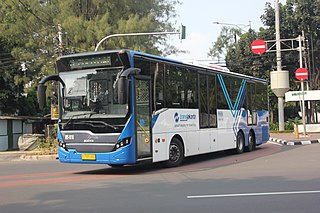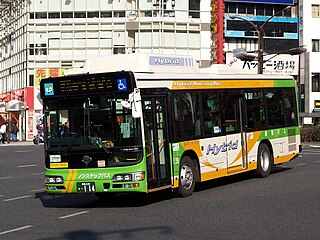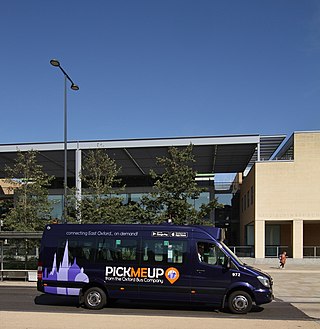
Bus rapid transit (BRT), also referred to as a busway or transitway, is a bus-based public transport system designed to have much more capacity, reliability and other quality features than a conventional bus system. Typically, a BRT system includes roadways that are dedicated to buses, and gives priority to buses at intersections where buses may interact with other traffic; alongside design features to reduce delays caused by passengers boarding or leaving buses, or paying fares. BRT aims to combine the capacity and speed of a light rail transit (LRT) or mass rapid transit (MRT) system with the flexibility, lower cost and simplicity of a bus system.

The Société de transport de Montréal is a public transport agency that operates transit bus and rapid transit services in the urban agglomeration of Montreal, Quebec, Canada. Established in 1861 as the "Montreal City Passenger Railway Company", it has grown to comprise four subway lines with a total of 68 stations, as well as 212 bus routes and 23 night routes. The STM was created in 2002 to replace the Société de transport de la communauté urbaine de Montréal. The STM operates the most heavily used urban mass transit system in Canada, and one of the most heavily used rapid transit systems in North America. As of 2019, the average daily ridership is 2,297,600 passengers: 977,400 by bus, 1,306,500 by rapid transit and 13,700 by paratransit service.

A hybrid electric bus is a bus that combines a conventional internal combustion engine propulsion system with an electric propulsion system. These type of buses normally use a Diesel-electric powertrain and are also known as hybrid Diesel-electric buses.

free bus is a zero-fare bus system that operates in Greater Manchester. The system was first introduced in Manchester city centre in 2002, with three routes linking the city's major thoroughfares and stations with its main commercial, financial and cultural districts.

Edinburgh is a major transport hub in east central Scotland and is at the centre of a multi-modal transport network with road, rail and air communications connecting the city with the rest of Scotland and internationally.

The public transport system of Otago is primarily based around the major cities of Dunedin and Queenstown. It includes the separate Orbus branded networks of Dunedin, and of Queenstown.

Public transport in Christchurch, New Zealand, consists of bus services operated by two bus companies supported by a ferry, all jointly marketed as Metro, a division of Environment Canterbury (ECan).
Transport in Invercargill, New Zealand is mostly by bus and private car.

Public transport in New Zealand exists in many of the country's urban areas and takes a number of forms. Bus transport is the main form of public transport. Two major cities, Auckland and Wellington also have suburban rail systems that have been gaining more patronage and new investment in recent years. Some cities also operate local ferry services. There are no rapid transit metros and no remaining tram systems active anywhere in New Zealand, though trams once had a major role in New Zealand's public transport.

Red Bus was a bus operator in Christchurch, New Zealand. Red Bus operated public transport bus services around Christchurch on behalf of the Canterbury Regional Council, and it operated the free inner city Shuttle on behalf of the city council until the 2011 Christchurch earthquake.
Environmental Performance Vehicles (EPV), previously DesignLine Corporation, is a manufacturer of coach, electric and range-extended electric (hybrid) buses. It was founded in Ashburton, New Zealand in 1985. Initially it was a manufacturer of tour coaches. In the 1990s it diversified into conventional transit buses and then added hybrid city buses in the late 1990s. It was acquired by American interests in 2006, and DesignLine Corporation's headquarters was relocated to Charlotte, North Carolina. Following a bankruptcy in 2013, the assets of DesignLine were sold and the company was renamed.

The Christchurch tramway system was an extensive network in Christchurch, New Zealand, with steam and horse trams from 1882. Electric trams ran from 1905 to 1954, when the last line from Cashmere to Papanui was replaced by buses.

Trams in New Zealand were a major form of transport from the 19th century into the mid-20th century. New Zealand's first (horse) tramway was established in 1862 (Nelson), followed by a steam tramway in 1871 (Thames), and the first electric tramway in 1900. In New Zealand railway terminology a bush tramway is an industrial tramway, which usually did not carry passengers.

Demand-responsive transport (DRT), also known as demand-responsive transit, demand-responsive service, Dial-a-Ride transit, flexible transport services, Microtransit or Non-Emergency Medical Transport (NEMT) is a form of shared private or quasi-public transport for groups traveling where vehicles alter their routes each journey based on particular transport demand without using a fixed route or timetabled journeys. These vehicles typically pick-up and drop-off passengers in locations according to passengers needs and can include taxis, buses or other vehicles. Passengers can typically summon the service with a mobile phone app or by telephone; telephone is particularly relevant to older users who may not be conversant with technology.

QuayLink was a bus service in Tyne and Wear, England, which connected Gateshead and Newcastle upon Tyne, and later North Tyneside, with the Quayside. Funded by the Tyne and Wear Passenger Transport Executive, the service was launched on 22 July 2005. Operated initially by Stagecoach North East, the service was transferred to Go North East in July 2010 – later being operated commercially from July 2015, following budget cuts.

Public transport bus services are generally based on regular operation of transit buses along a route calling at agreed bus stops according to a published public transport timetable. The state of Tamil Nadu in India operates the world's largest bus corporation called as TNSTC which is fully owned by Government of Tamil nadu, with a fleet of 20,258 buses and a daily ridership of 17 million.

The Bus Exchange was the main public transport facility in the central city of Christchurch, New Zealand. Part of it was indoor and featured airport-style lounges. The Bus Exchange opened in November 2000 and closed due to the February 2011 Christchurch earthquake, which damaged the building beyond repair. The replacement facility, the Bus Interchange, opened across the other side of Lichfield Street in May 2015.

San Leandro LINKS or West San Leandro Shuttle usually referred to simply as the Links Bus is a free public transit service in San Leandro, California. It is run by the San Leandro Transit Management Organization.

The Christchurch Transport Board was an autonomous special-purpose municipal authority responsible for the construction, acquisition, and ownership of local transport assets and the operation of public transport services in the Christchurch region of New Zealand's South Island. Constituted as the Christchurch Tramway Board in 1902, it operated trams and buses to Christchurch's outer suburbs and satellite towns for 84 years until being disestablished in the 1989 local government reforms.

The Central City Red Zone, also known as the CBD Red Zone, was a public exclusion zone in the Christchurch Central City implemented after the 22 February 2011 Christchurch earthquake. After February 2013, it was officially renamed the CBD Rebuild Zone by government agencies, but remained known as the Red Zone. It gradually shrank in size and the last cordons were removed on 30 June 2013, 859 days after the earthquake.


















